In the construction of modern storage facilities, steel structure warehouses have become one of the mainstream building forms due to…
Prefab steel structure warehouse building comprises beams, columns, trusses, purlins, and more. These components are connected using welding or bolting technology. The parts are prefabricated in the factory and then transported to the construction site, assembled to form a complete building structure.
The Structure of Prefab Steel Structure Warehouse?
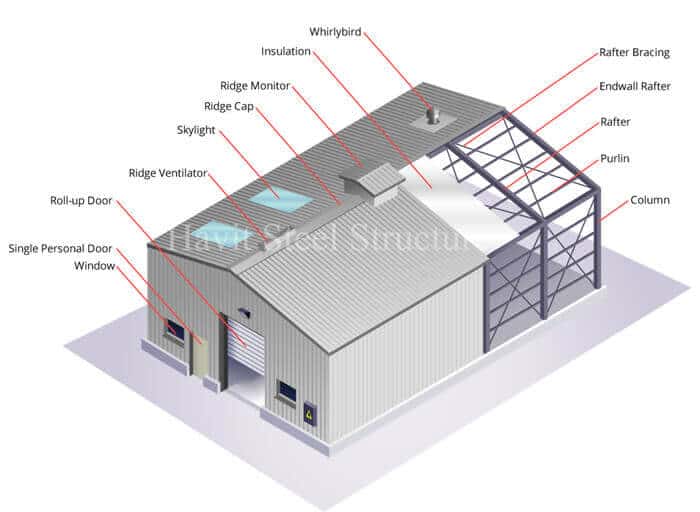
There are two primary structural forms of prefab steel warehouses: metal rigid frame and truss. The roofs and walls of these buildings are clad in corrugated metal panels or sandwich panels that are insulated with various materials to maintain temperature and humidity levels.
Prefabricated steel structure warehouses are widely used in logistics, warehousing, industrial production, and other fields due to their superior characteristics and suitability for storage needs of various scales.
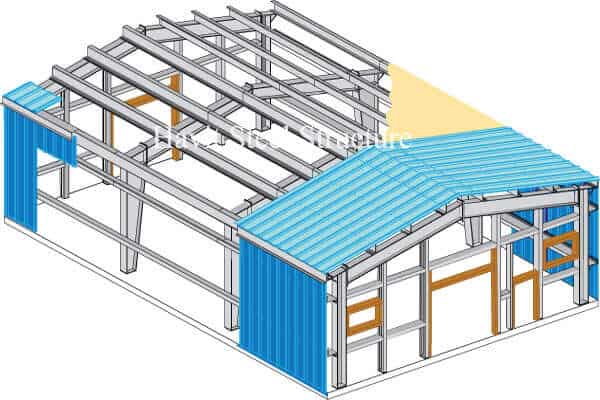
The details of the Prefab Steel Structure Warehouse Building:
Design and Planning
Prefabricated warehouse buildings need to develop a comprehensive plan based on the area of the land. This planning stage takes into account several key factors, such as: the location of the warehouse, the intended use, the budget, the building size, whether it will be expanded later, and so on.
After confirming the building size, it is necessary to decide whether it is single-span or multi-span. After determining the intended use, consider single-story or multi-story.
Small and medium-sized warehouses can choose single-span and single-story structures, while large steel structure warehouse need to adopt multi-span structures. If the land area is limited, multi-story building structures can be selected. For example, we exported a six-story steel warehouse building to Panama. Multi-story warehouses can meet the storage needs of a large area on limited land.
The following are suggestions for prefabricated warehouse building plans:
Economic span
The span of the warehouse is a key factor to consider when planning. According to our experience, a span of 18-24 meters is more economical, and this size can also meet the needs of most warehouses.
Warehouse height
The height of the warehouse needs to be determined according to the height of the goods stored inside. The height cannot be set blindly. The higher the height, the higher the price. For most single-story warehouses, a 6-meter elevation is usually used. If there is a special need, the height should be increased. The height of a single-story warehouse should not exceed 12 meters.
Warehouse with mezzanine
Many owners will consider designing a mezzanine inside the warehouse, which can be used as an office. The mezzanine is best arranged at the end, so as not to affect the operation of the warehouse. The mezzanine height is designed to be about 3 meters. The steel warehouse we designed in Papua New Guinea is of this layout.
Differences in the size of prefab steel structure warehouse
The size of the prefab steel structure warehouse varies from country to country and region to region and is usually designed and adjusted according to local building codes, climatic conditions, land use regulations, and industry needs. The overall size of the building not only affects the storage capacity but is also closely related to land utilization, construction costs, and functionality.
Building size:
Generally speaking, the area of a steel structure warehouse usually accounts for between 60% and 80% of the total land area. For example, suppose the total area of a piece of land is 5,000 square meters. In that case, the building area will be approximately 3,000 to 4,000 square meters, which includes the warehouse area, office building, supporting facilities, and possible logistics areas.
Crane runway system:
Do you need to install overhead cranes in your warehouse?
Evaluate whether the prefab steel warehouse needs to install a crane. This decision usually depends on the type of goods stored in the warehouse. If the goods are heavy, forklifts cannot meet the workload, so a crane needs to be installed. When installing a crane, you need to consider the lifting height of the crane. According to the operational requirements of the warehouse, choose the appropriate lifting height and ensure that the warehouse has enough space to accommodate the operation of the crane.
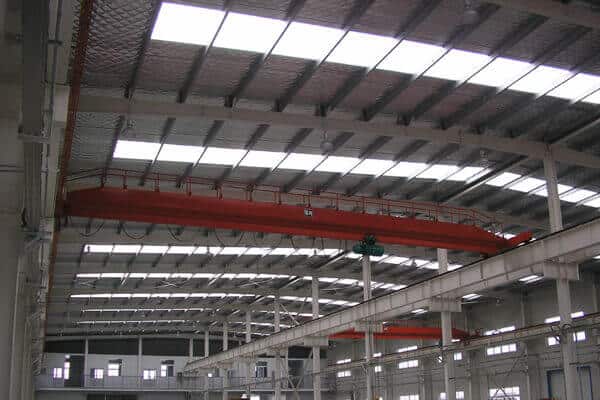
Foundation of Steel Structure Warehouse
Overview of the foundation construction of the steel structure warehouse
The foundation of steel structure warehouses is usually built by local civil engineering companies. Steel structure manufacturers will provide detailed structural design information, including data such as bending moment, shear force and axial force of steel columns. Civil engineering contractors design and calculate the foundation based on this information.
Key considerations for foundation design
The steel structure foundation is an independent foundation. The bearing capacity needs to be considered when designing the foundation. When the bearing capacity of the foundation is insufficient, the most direct method is to reinforce the foundation, such as grouting reinforcement, pile foundation reinforcement, etc.
Steel frame
The steel frame is the load-bearing structure in a warehouse building. The steel frame system is usually composed of steel columns and roof frames. Because the steel frame is highly strong, lightweight, and durable, it has become the most common structural form in warehouse buildings.
Portal steel frame and truss structure are the two most common steel frame forms. In addition to the primary steel frame structure, prefab steel warehouses also require secondary structures to provide additional support and stability. Secondary structures include: bracing, pipe strut, and purlins. The primary and secondary structures cooperate with each other to form a complete force system to ensure the safety and durability of the warehouse building.
Roof and wall
The roof and wall are essential components of prefabricated warehouse buildings. They not only bear the pressure of the external environment but also protect the building from natural conditions such as wind, rain, snow, and sunlight. Good roof and wall design can effectively isolate external climate changes and provide a safe, dry, and comfortable storage environment. Therefore, the roof and walls of the warehouse play a vital role in ensuring structural stability, extending the life of the building, and improving energy efficiency.
Typical roof and wall materials: corrugated color steel sheet:
Corrugated color steel sheet is the most common roof and wall material. The color metal sheet is a metal plate with a color coating on the surface of the steel plate. It is light in weight, corrosion-resistant, simple and quick to construct, and is widely used in the roof and wall of warehouse buildings.
Insulation material
For some warehouses that need insulation, especially when storing items with high temperature requirements, the insulation performance of the roof and walls is particularly important. In order to ensure the stability of the internal temperature of the warehouse, it is usually necessary to lay insulation materials on the roof and walls. Commonly used insulation materials include glass wool and rock wool.
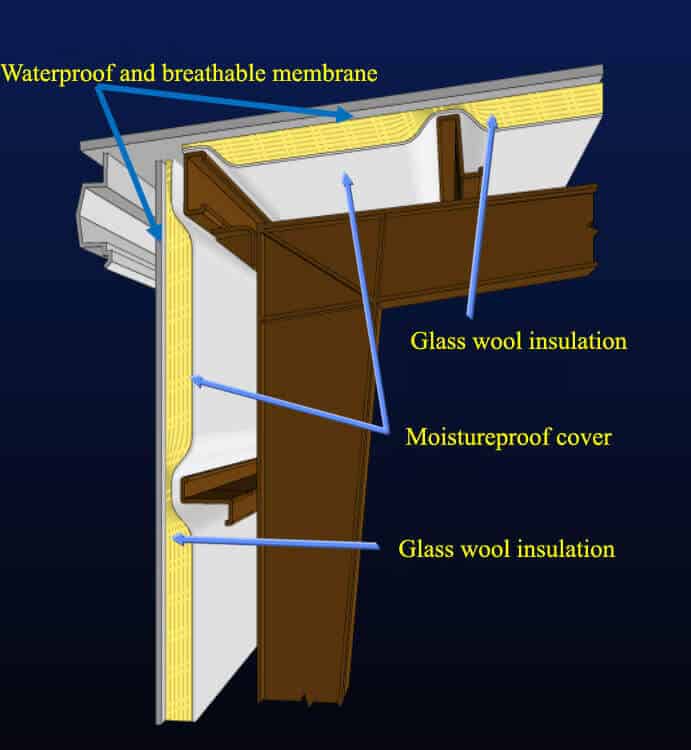
Ventilation
For general prefab steel warehouse buildings, ventilation using a roof fan and air tower is sufficient. However, for some warehouses that produce more smoke and odor, natural ventilation can no longer effectively discharge harmful gases into the room.
For this type of steel structure warehouse, the best way to solve the ventilation, cooling, and smoke exhaust problems is to install a large exhaust fan on the roof to exhaust air to the outside, form indoor negative pressure, press a large amount of fresh air into the room from all sides to form air convection; this way, the ventilation and smoke exhaust effect is better.
Environmental conditions:
What is the local weather condition? Whether Is there a strong wind and snow in winter?
Considering the environment when designing a prefabricated steel warehouse building is essential. Factors such as wind speed and snowfall will directly affect the building’s safety and stability. Therefore, when designing the structure, we need to comprehensively analyze and calculate the wind load and snow load that the steel frame needs to bear to ensure that the structure can be used normally under various climatic conditions.
Calculation of wind load
Wind load refers to the pressure generated by wind on the surface of the building. Strong winds may significantly impact the building structure, especially in coastal areas with frequent hurricanes. In order to calculate the wind load accurately, we need to understand the local wind speed, usually in meters per second (m/s) or kilometers per hour (km/h). Wind speed varies from region to region, so it is necessary to clarify the local wind speed during the design stage.
Calculation of snow load
Snow load is also a factor that cannot be ignored in the design for areas with snow accumulation in winter. Snow load refers to the pressure generated by snow on the building’s roof. In order to ensure that the steel structure warehouse can withstand the weight of snow, we will calculate the snow load on the roof according to the snow data in the area in the design to ensure that the building can remain stable in the cold season.
Doors and windows:
Do you need doors and windows for the warehouse?
Doors and windows also play an essential role as accessories when designing a steel structure warehouse. It is crucial to choose the right type of doors and windows according to the warehouse’s different usage needs and specific requirements. We provide a range of customized door and window options to meet the access, ventilation, and safety needs of various warehouses.
Windows: Aluminum Alloy Windows
We can customize the size, quantity, and opening method of windows according to your needs to achieve the best ventilation effect or natural lighting.
Doors: Rolling Doors, Sliding Doors, Pedestrian Doors
We provide a variety of door types for you to choose from to ensure that the functional requirements of different warehouses can be met.
Parameters of single-story warehouse building:
Length: depends on your requirements.
Column spacing is generally 6m, but it can also be 7.5 meters, 9 meters, or 12 meters, depending on your requirements.
Span: generally 9-36 meters. We can design it as a single-span, double-span, or multiple-span.
Height: 4.5-9 meters (no overhead crane installed in the warehouse)
When installing one or more overhead cranes in your facility, you should specify the lifting capacity and height of the crane to determine the height of the warehouse building.
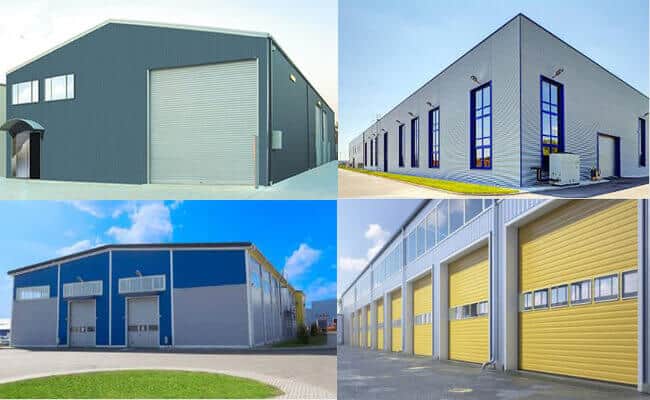
The attention to the design:
Focus on the load-bearing design
A steel structure warehouse design requires careful consideration of multiple design aspects. Factors such as weight capacity, pressure resistance, material strength, tensile strength, and load transfer must be considered. The thickness of the steel must also be determined to ensure the structure is solid and functional. A comprehensive process must ensure all these questions are answered, and the prefab warehouse is built to the highest standards.
The design of the steel structure warehouse has been carefully considered to minimize the potential for damage. Additionally, this construction method facilitates regular maintenance and increases the structure’s longevity.
Pay attention to lighting design.
Lighting is an essential factor that can have a direct impact on a warehouse’s atmosphere. To save energy, properly designing the lighting system in a steel warehouse is essential. This can be done by placing lighting panels at specific locations on the metal roof, installing lighting glass, and using natural light as much as possible while ensuring waterproofing to maximize the service life. Doing so will result in an optimal lighting effect.
What are the differences between a metal warehouse and a traditional concrete warehouse?
Warehouses are essential for storing goods and commodities and have traditionally been constructed with concrete structures. However, in recent years, the demand for warehouse construction has shifted, leading to the rise of steel-structured warehouse buildings. This new model allows entrepreneurs to better meet the needs of the market.

- The construction of the steel structure warehouse is rapid, and the emergency advantages are apparent, which can meet the sudden storage needs of the enterprise.
- The steel structure warehouse is dry construction with outstanding environmental protection advantages. It can reduce the impact of project construction on the environment and nearby residents, which is better than the wet construction of reinforced concrete buildings.
- Prefab steel warehouse can save construction and workers’ costs compared with traditional concrete warehouses. Building a steel structure warehouse is 20% to 30% lower than a typical warehouse construction cost and more secure and stable.
- The steel structure is light in weight, and the building materials used in the walls and roof are much lighter than those in brick-concrete walls and terracotta roofs, which can effectively reduce the overall weight of the steel structure warehouse without compromising its structural stability. At the same time, it can also reduce the transportation cost of components formed by off-site migration.
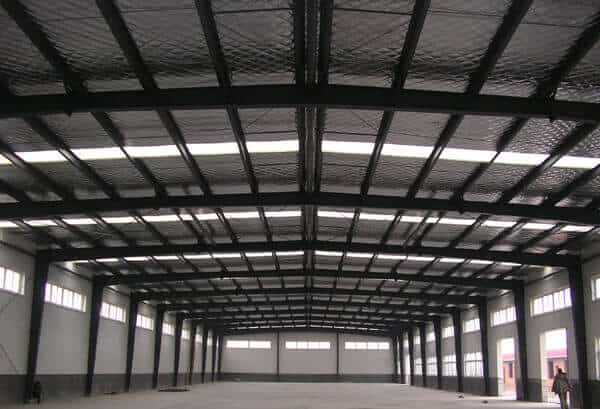
The advantages of a Prefab Steel structure warehouse:
1. The design considerations for a prefab steel structure warehouse
1. Structural integrity: The structure must be designed to withstand the loads imposed by the environment, such as wind, snow, and seismic activity.
2. Ease of assembly: The structure must be designed to be easily assembled and disassembled.
3. Cost: The structure’s cost must be considered when designing the warehouse.
4. Durability: The structure must be durable and withstand the elements.
5. Fire safety: The structure must be designed to meet fire safety regulations.
6. Energy efficiency: The structure must be designed to be energy efficient.
7. Accessibility: The structure must be designed to be accessible for people and equipment.
2. Cost-effectiveness
The cost of a prefab steel structure warehouse building will depend on several factors, including the size of the warehouse buildings, the type of steel used, the design’s complexity, and the warehouse’s location. Generally, prefab steel warehouses are more cost-effective than traditional warehouses due to their quick and easy assembly, as well as their durability and low maintenance costs.
Faster design and construction process.
If your warehouse plan is submitted to a steel structure manufacturer company, the building will be pre-designed and manufactured by experts. It makes the entire process from start to finish more economical, resulting in ready-made steel construction components shipped directly to the worksite.
It has reduced labor costs.
Since the warehouse is prefabricated chiefly, construction time can be reduced by as much as 30% to 50% or more based on the experience level of the construction personnel. Time is money, so the faster you build, the less you spend on labor.
Reduce maintenance costs
Due to the low maintenance cost of the steel structure, the building owner saves on general maintenance, repair, and replacement throughout the building’s life.
3. Endurance
Steel buildings are renowned for their stability, strength, and durability, making them the perfect choice for areas prone to extreme weather conditions, such as high-wind areas and seismic zones. Steel structures resist common threats to wood, such as decay, mildew, pests, and fire. Also, steel structures are designed to be more resilient to wind, snow, and seismic activity, making them ideal for disaster evacuation centers and other places where large gatherings may be necessary for emergencies. Steel-framed gymnasiums, schools, and other municipal buildings are often chosen for their ability to withstand typhoons and other natural disasters.
4. Clearspan
The steel structure is economical for large warehouses, manufacturing, and distribution operations. Steel buildings offer the industry’s most expansive architectural clear spans, allowing for more usable space. This means fewer structural obstructions, and installing large-scale industrial machinery, vehicles, and personnel within the building is accessible. The structure also ensures the safe movement of personnel and equipment.
5. Environmental friendly
Eco-friendliness is not just a trend. Data shows that building owners and customers who buy products and services increasingly demand green buildings. The steel structure is a sustainable building product because it uses recycled materials in production and is 100% recyclable at the end of its service life.














